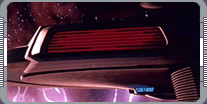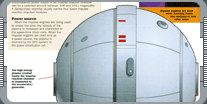
Impulse Engines
Starfleet ships employ impulse engines powered by deuterium to travel at sub light speeds.
 Impulse engines are used in sub-light speed flight, and to provide a secondary power supply for the ship's
onboard systems at all times. Impulse engines should not be confused with maneuvering thrusters, which are
used when pinpoint accuracy is needed, such as inside
Spacedock. The impulse drive is normally used within a solar
system or within regions of space such as the Badlands, which are incompatible with the warp field. Each
engine has four parts; the impulse reaction chamber, the accelerator, the driver coil, and the vectored
exhaust director powered by a proton-antiproton fusion reaction. Cryogenic deuterium is stored in primary
and auxiliary fuel tanks in both saucer and engineering sections of the ship. Once the reaction (or
explosion) has occurred in the reaction chambers, the destination for the resulting high-energy plasma
depends on whether the energy generated was needed to move the ship or power the systems.
Impulse engines are used in sub-light speed flight, and to provide a secondary power supply for the ship's
onboard systems at all times. Impulse engines should not be confused with maneuvering thrusters, which are
used when pinpoint accuracy is needed, such as inside
Spacedock. The impulse drive is normally used within a solar
system or within regions of space such as the Badlands, which are incompatible with the warp field. Each
engine has four parts; the impulse reaction chamber, the accelerator, the driver coil, and the vectored
exhaust director powered by a proton-antiproton fusion reaction. Cryogenic deuterium is stored in primary
and auxiliary fuel tanks in both saucer and engineering sections of the ship. Once the reaction (or
explosion) has occurred in the reaction chambers, the destination for the resulting high-energy plasma
depends on whether the energy generated was needed to move the ship or power the systems.
If the goal is to generate propulsion, then the plasma is sent to the accelerator, which further excites the
high-energy plasma. Next, the plasma is pushed through the space-time driver coils, which reduces the internal
mass of a starship, making it possible for space-time to slide past the ship a little more easily. Finally,
 the reaction by-products vent through the vectored exhaust directors to produce propulsion - along the same
principles used to propel the old chemically fueled rocket ships. If ship systems need power rather than
thrust, then the high-energy plasma coming through the impulse reaction chamber is sent through an inactive
accelerator and diverted to the Electro-Plasma System (EPS), which disburses the energy as needed. It is also
possible to use impulse energy simultaneously for propulsion and internal power, by keeping the accelerator
active and bleeding off some of the excited, high-energy plasma for distribution via the magneto-hydrodynamic
(MHD) system. The Galaxy-class impulse system is based on a
design that has altered little since 2169, and only uses one millionth of the energy required by warp drives.
Impulse engines place greater demands on the crew than the warp engines; they require 1.6 hours' maintenance to
every one hour spent on the warp system. The reaction chamber has to be replaced every 10,000 hours and the
accelerator and drive coil assemblies swapped out every 6,250 hours. Most of these components have to be
changed in Spacedock. On the Galaxy-class the four main impulse engines located on deck 23 share, with warp
power systems, the responsibility of powering the ship's computers and internal systems. If warp power could
not be spared or went offline, main impulse power could shoulder the entire job. The load-sharing decisions and
switch-offs are managed by the computerized impulse power system command coordinator. This coordinator is also
linked with the warp power coordinator and the Reaction Control System (RCS). The latter also ensures that the
right kind of power is delivered where it is needed. Two sets of two impulse engines are positioned on deck 9,
the reaction by-products vent through the vectored exhaust directors to produce propulsion - along the same
principles used to propel the old chemically fueled rocket ships. If ship systems need power rather than
thrust, then the high-energy plasma coming through the impulse reaction chamber is sent through an inactive
accelerator and diverted to the Electro-Plasma System (EPS), which disburses the energy as needed. It is also
possible to use impulse energy simultaneously for propulsion and internal power, by keeping the accelerator
active and bleeding off some of the excited, high-energy plasma for distribution via the magneto-hydrodynamic
(MHD) system. The Galaxy-class impulse system is based on a
design that has altered little since 2169, and only uses one millionth of the energy required by warp drives.
Impulse engines place greater demands on the crew than the warp engines; they require 1.6 hours' maintenance to
every one hour spent on the warp system. The reaction chamber has to be replaced every 10,000 hours and the
accelerator and drive coil assemblies swapped out every 6,250 hours. Most of these components have to be
changed in Spacedock. On the Galaxy-class the four main impulse engines located on deck 23 share, with warp
power systems, the responsibility of powering the ship's computers and internal systems. If warp power could
not be spared or went offline, main impulse power could shoulder the entire job. The load-sharing decisions and
switch-offs are managed by the computerized impulse power system command coordinator. This coordinator is also
linked with the warp power coordinator and the Reaction Control System (RCS). The latter also ensures that the
right kind of power is delivered where it is needed. Two sets of two impulse engines are positioned on deck 9,
 in the saucer section's aft port and starboard areas. They were installed to power both internal and propulsion
systems on the saucer section if separation took place. During normal operations, full impulse is only 0.25c -
above this, problems tend to occur. If a ship travels at half the speed of light engine efficiency will fall to
85 percent, and if it travels at impulse speeds above 0.75c relativistic problems may occur.
in the saucer section's aft port and starboard areas. They were installed to power both internal and propulsion
systems on the saucer section if separation took place. During normal operations, full impulse is only 0.25c -
above this, problems tend to occur. If a ship travels at half the speed of light engine efficiency will fall to
85 percent, and if it travels at impulse speeds above 0.75c relativistic problems may occur.
Traveling at high sub light speeds could cause convoluted relativity and synchronicity problems. To give a
simplified explanation, the faster one travels, the slower time moves. This means that at speeds approaching
light speed, an hour will take longer to pass on the ship than on Earth. Because the warp engines overcome
many of the problems associated with Newtonian physics, this problem does not exist at warp speed. In order to
minimize this effect, a ship rarely travels at more than 0.25 impulse and the clocks continually update
themselves to remain in sync with official Starfleet time.
|
|
"PROPULSION SYSTEMS" - JUNE 2000 ISSUE 14 STAR TREK: THE MAGAZINE
"USS ENTERPRISE NCC-1701-D" - JANUARY 2001 ISSUE 21 STAR TREK: THE MAGAZINE
COPYRIGHT OF PARAMOUNT PICTURES.
|